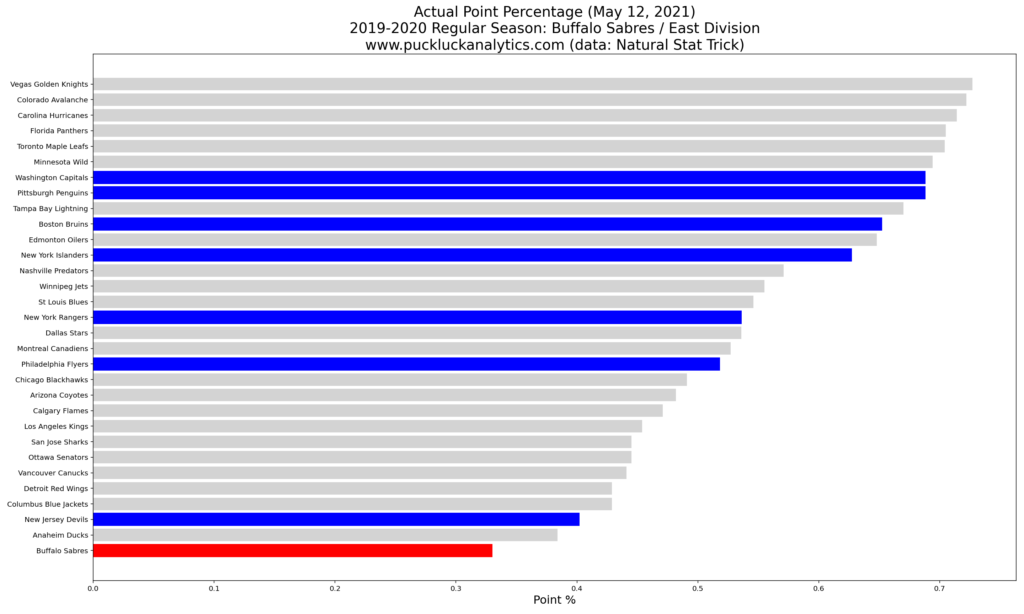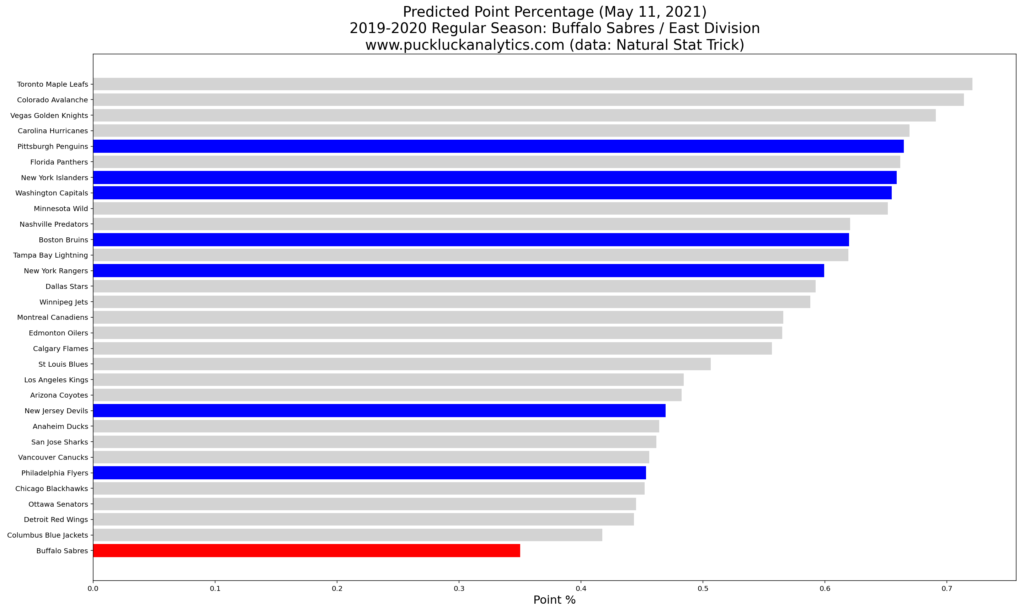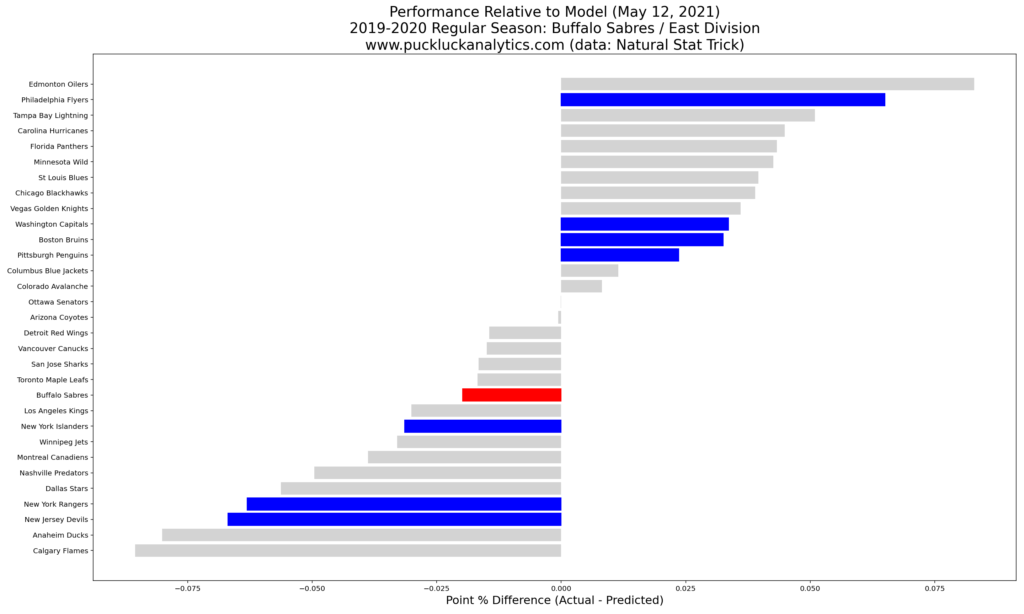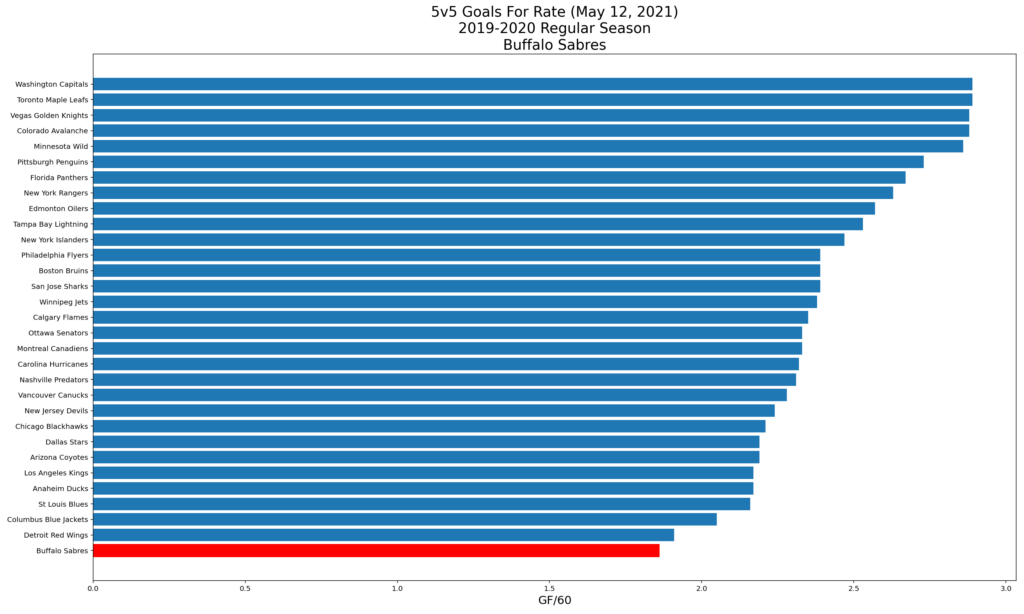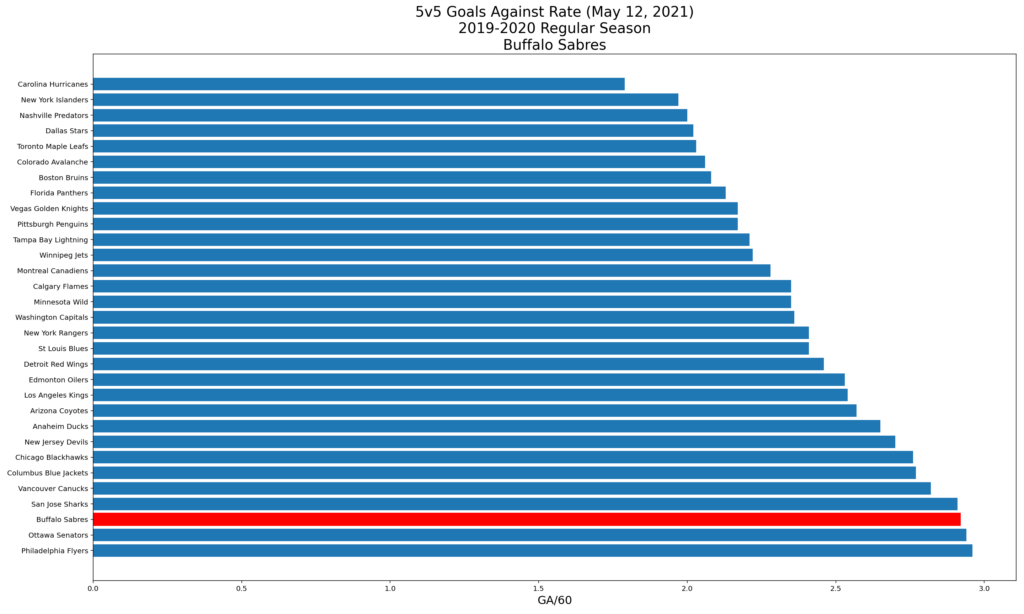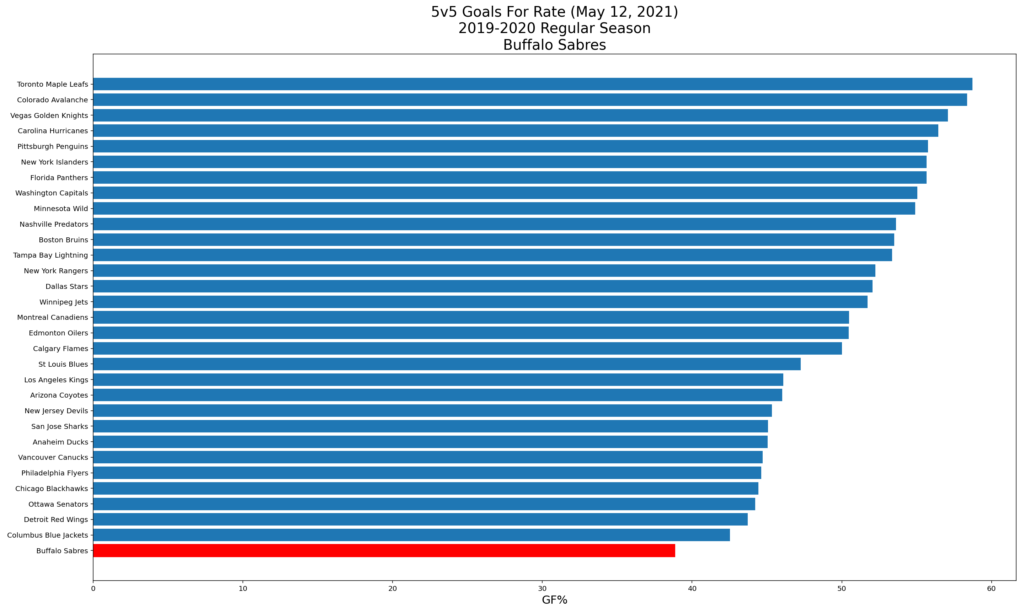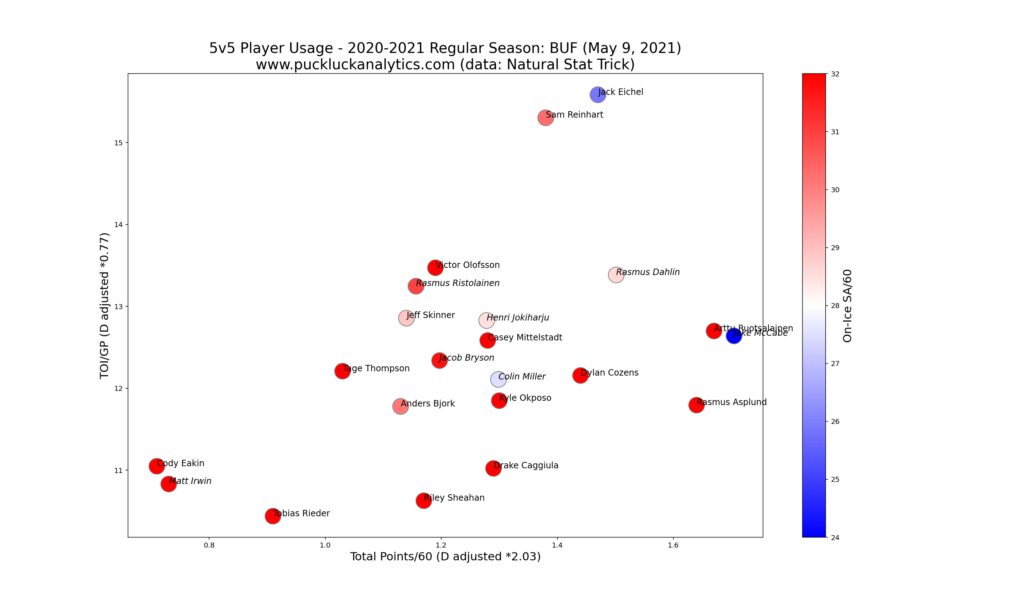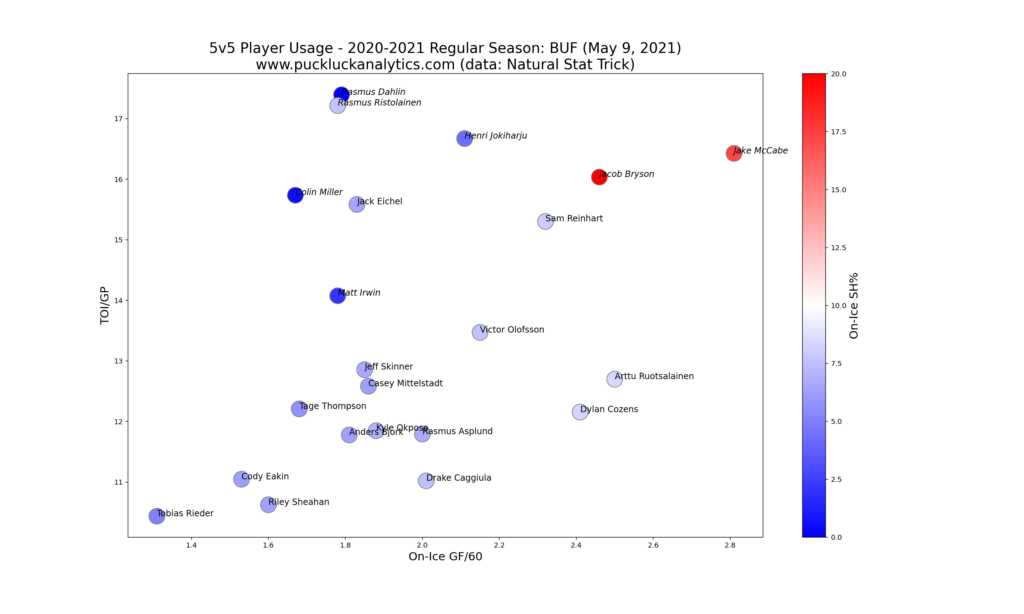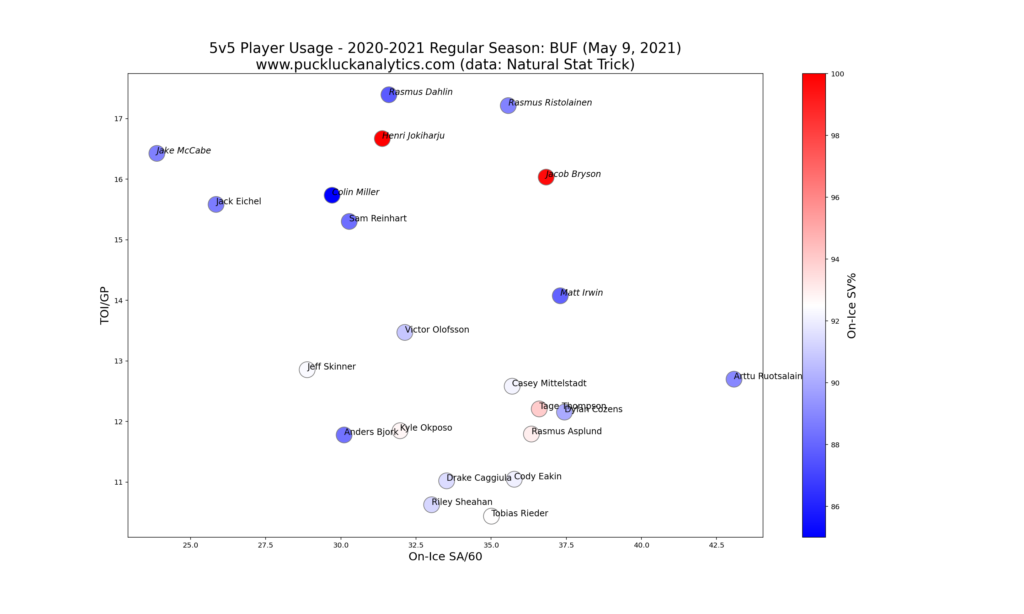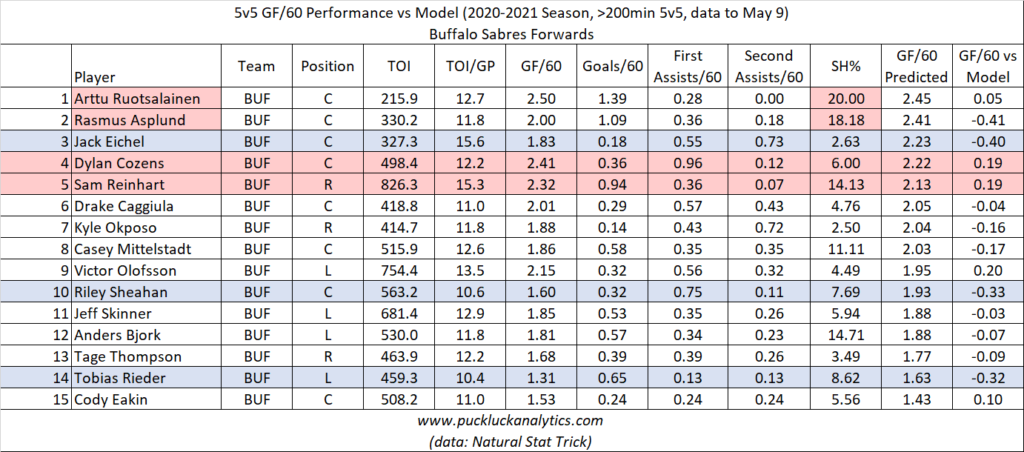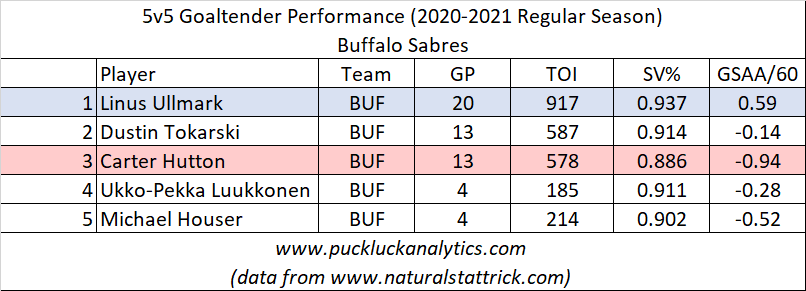The East Division completed the regular season on Tuesday night and I’m making it the second stop in my season reviews as I look at the Buffalo Sabres. Check out my post on the process I’m using to evaluate the season for more detail on what I’m looking for in the plots.
The 2020-2021 season was one to forget in upstate New York. The Sabres finished dead last in the NHL, tying the record for longest losing streak in the process. During exit interviews, superstar Jack Eichel made it clear that he wants out.. Were there any positives in the Sabres tumultuous season? Where do they go from here?
Team Overview
We’ll start by looking at the Sabres point percentage and compare it to our model prediction, which uses 5v5 goal rates as input.
The Sabres finished 31st overall by a significant margin. Our model agrees that they should have beena bottom feeding team based on the Sabres’ 5v5 goal rates, although it suggests they should have had slightly better results than they actually did this season. Given their 18 game losing streak came on the heels of a covid outbreak, it’s reasonable to suspect that there was a negative impact on performance from the outbreak that we don’t expect to recur.
Since we use 5v5 goal rates as input to the points predictor model, let’s take a look at these numbers as well.
It’s clear that the Sabres struggled on both sides of the puck and it appears that offense was a bigger struggle than defense. Ranked dead last in GF/60 at 5 on 5, there is a significant gap to close with even the 29th place Blue Jackets. Defensively, they find themselves grouped more closely with the other teams around them. While the Sabres need improvement all around, they need it more desperately on offense.
Player Performance
Let’s shift focus to player performance. We’ll first look at how player performance impacted overall team performance, as well as assess player usage. First, we’ll look at a usage chart with defensemen points and ice time adjusted for comparison to forwards. Ideally, we should see a team depth chart on the diagonal from top right to bottom right.
Jack Eichel and Sam Reinhart stand out as the top players on the team, as expected. Ideally, we’d like to see their point production higher based on their time on ice. Eichel was plagued by an unsustainably low 2.6% shooting percentage this season, which we can expect to improve next season. Reinhart was the opposite, shooting over 14%, which makes us wonder if he was thrust into too large a role on a weak Sabres team.
The other thing that stands out is that Eichel and Jake McCabe have much lower on-ice SA/60 than the rest of the team. This suggests they had a positive impact on team defense when they were on the ice, particularly given most of the team looks like they were consistently shelled. Colin Miller, Rasmus Dahlin, Henri Jokiharku, and Jeff Skinner were also better than the majority of the team in this regard, but not to the extreme extent of Eichel and McCabe.
The point production we see in the usage chart feeds into our GF/60 model. Combined with TOI/GP, this gives us a visual of the relative impact on team GF/60 that each player had. See the season review overview for more detail.
Sam Reinhart stands out among the forwards as having by far the largest contribution to team GF/60 this season. As we previously noted, Eichel’s shooting percentage was very and we expect a bounce back next season. Dylan Cozens and Artuu Ruotsalainen had strong offensive contributions and look like they could have a larger positive impact given additional ice time.
Among defensemen, McCabe and Jacob Bryson stand out with the largest offensive impacts. However, they also stand out as having benefitted from high on-ice shooting percentage which is likely to regress in the future. Dahlin and Rasmus Ristolainen recevied plenty of 5v5 ice time, yet their offensive production was not enough.
Looking at on-ice SA/60 vs TOI/GP gives us a visual depiction of player impact on team GA/60. As we noted on the first usage chart, we see again that Eichel and McCabe had strong positive impacts on team defense with the lowest SA/60 at 5 on 5 while getting a significant amount of ice time. The group of players around 30 SA/60 includes the other players we noticed defensively on the first chart as well. While we saw Dahlin and Ristolainen had almost identical offensive impact in the GF/60 chart, here it’s clear that Dahlin’s overall impact was more positive since his defensive impact was better. In general, we see lower on-ice save percentages in the top half of the chart, which suggests the Sabres most utilized players likely played against top players on opposing teams.
Now we’ll switch focus to our on-ice GF/60 models. Using player goal and assist rates as input, we can predict their on-ice GF/60. The difference between actual and predicted values can give us an indication of whether a player’s offensive impact was dragged down or buoyed by his line mates. This, in turn, can give us insight into which players are ready for larger roles or should have their roles reduced.
Arttu Ruotsalainen and Rasmus Asplund immediately jump out among forwards, with the highest predicted on-ice GF/60. However, they both benefited from extremely high shooting percentages this season that are likely to regress significantly. Since our model uses goals/60 as an input, the model is predicting their GF/60 higher than it should be and we should temper out expectations for these two players next season.
Eichel, Riley Sheahan, and Tobias Reider stand out as having underperformed the model by a significant margin. Sheahan and Reider both had relatively average SH% so we can trust the model output is reasonable. Eichel’s SH% was very low, suggesting that the gap between model and reality should be even larger. These three players look like they carried their line mates offensively. Sheahan and Rieder look like they could take on larger roles. While Eichel is already a top line player, he would likely benefit from playing with better line mates.
Dylan Cozens and Sam Reinhart both overperformed the model, suggesting they were carried by their line mates offensively. This doesn’t suggest that they aren’t quality players, but they may have been thrust into larger roles than ideal on a weak team. They would likely both provide an improved overall impact for the team if their roles were reduced slightly.
We see some large discrepancies from the model among the Sabres’ defensemen, both positive and negative. McCabe and Bryson both overperformed the model, suggesting that they were carried by others offensively. This makes sense given we saw that both these players benefited from very high on-ice shooting percentages this season. They may benefit from a slightly reduced role. On the flip side, Dahlin, Miller and Ristolainen underperformed the model. This suggests that these defensemen carried their team mates offensively and may be a reflection of the overall poor quality of forward depth the Sabres have.
Goaltending provided a bright spot for the Sabres this season. Over 20 games played, Linus Ullmark put up a 0.937 save percentage at 5v5. Considering he did it on a team as weak defensively as the Sabres makes it even more impressive. While Carter Hutton struggled to a 0.886 save percentage, it opened the door for Dustin Tokarski to return to the NHL level. Tokarski was another bright spot, posting a respectable 0.914 save percentage over 11 games.
Looking Ahead
The Sabres have a few UFAs this summer, along with a number of RFAs. With just $49.8M cap hit committed for next season, they have flexibility.
Key RFAs:
Sam Reinhart was one of the most impactful players for the Sabres this season, contributing offensively and defensively. While we saw that he may benefit from a slightly reduced role, he can be a quality second line player.
Still just 22 year old, Casey Middlestadt’s offensive impact was among the stronger of the Sabres forwards this year. His defensive impact needs some improvement but he can slot into the middle six.
Rasmus Dahlin is at the end of his entry level deal. While the Sabres would like to see more offense out of the 21 year old, we saw that he had a positive effect on his line mates’ offense impact and his defensive impact was respectable. As a developing young defensemen, he could be a key piece for the Sabres for years to come.
Another player finishing his entry level deal, Henri Jokiharju’s results stood out in our analysis. With strong defensive impact relative to most of the Sabres and reasonable offensive impact, he looks like a nice depth piece for the Sabres defense corps.
Key UFAs:
Jake McCabe heads to free agency following a strong showing this season. While his numbers may have been buoyed by high on-ice shooting percentage this season, he was one of the Sabres most impactful players. At 27 years old, there will be some interest from other teams and the Sabres will have a whole to fill should he sign elsewhere.
Linus Ullmark had a strong showing with the Sabres this season as he heads to the open market. At age 27, and arguably the top player for the Sabres this year, the Sabres should certainly consider re-signing him.
Key Players Under Contract:
Jack Eichel is the best player on the Sabres roster and currently in his prime. While his production was down this season, his 2.63% shooting was a major factor and we can expect a bounce back next season.
With 6 years left at a $9M cap hit, the Sabres need more out of 28 year old Jeff Skinner. While his 5.94% shooting suggests a modest improvement can be expected next season, our GF/60 model matched his actual offensive impact very closely. It’s likely unreasonable to expect much more from Skinner.
We noticed Colin Miller as having a relatively strong defensive impact for the Sabres and, based on our model, he carried line mates offensively. With one year left before he hits unrestricted free agency, the Sabres will need to decide how the 28 year old fits into their future plans.
Tough Questions:
Jack Eichel made it clear that there is a rift between himself and the Sabres organization in his exit interview and the Sabres need to resolve the issue this offseason. One way to do so would be to move Eichel. Given the current state of the team, this may be a good approach to (re)start a rebuild. At age 24, Eichel is in his prime and could be a key contributor on a team ready to win now. The Sabres are not that team currently, so should they move Eichel while his value is highest?
If the Sabres decide to tear it down, should they consider trading Sam Reinhart? As one of a few Sabres whose performance stood out in a positive light this season, the 25 year old’s value may never be higher. Depth at center is coveted in today’s NHL and there would be plenty of interest in Reinhart as a middle six forward if he became available.
Offseason Priority:
The Sabres need to decide whether they are going to tear down again to accelerate a rebuild or whether they will try to add pieces to help their current group. Regardless of the decision, they also need to resolve the rift with Jack Eichel. If they go the tear down route, trading Eichel and getting a good return is paramount. If they go with the second option, they need to smooth things over with Eichel and add some top 6 forwards to play with Eichel and Reinhart.
The Anahiem Ducks are next up in my season reviews. Subscribe to make sure you catch the all the reviews as they come out.
data: Natural Stat Trick
cap data: CapFriendly

